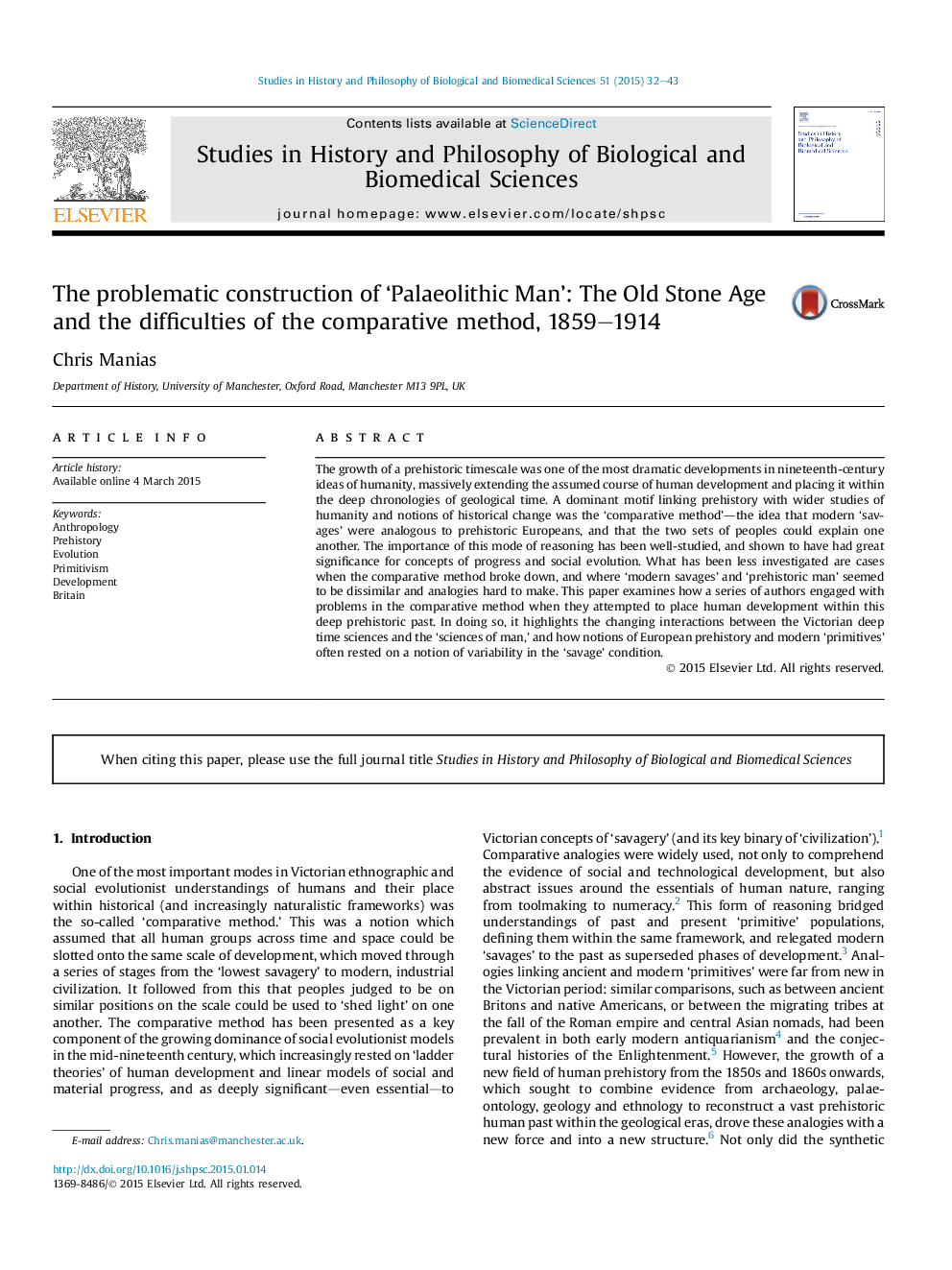| کد مقاله | کد نشریه | سال انتشار | مقاله انگلیسی | نسخه تمام متن |
|---|---|---|---|---|
| 7552388 | 1490514 | 2015 | 12 صفحه PDF | دانلود رایگان |
عنوان انگلیسی مقاله ISI
The problematic construction of 'Palaeolithic Man': The Old Stone Age and the difficulties of the comparative method, 1859-1914
ترجمه فارسی عنوان
ساخت و ساز مشکل ساز "مرد پائولیت": عصر قدیمی سنگ و مشکلات روش مقایسه، 1919 1859
دانلود مقاله + سفارش ترجمه
دانلود مقاله ISI انگلیسی
رایگان برای ایرانیان
کلمات کلیدی
مردم شناسی، تاریخ انقضا، سیر تکاملی، اولیویسم، توسعه، بریتانیا،
ترجمه چکیده
رشد یک دوره زمانی ماقبل تاریخ، یکی از تحولات چشمگیر در ایده های قرن نوزدهم بشریت بود، انعطاف پذیری روند پیش بینی شده توسعه انسانی و قرار دادن آن در محدوده زمانی عمیق زمین شناختی. یک مضمون غالب که پیش از تاریخ با مطالعات وسیع تر از بشریت و مفاهیم تغییر تاریخی پیوند خورده است، روش «مقایسه ای» بود: این ایده که وحشیان مدرن، مشابه با اروپایی های ماقبل تاریخ بودند و دو مجموعه مردم می توانستند یکدیگر را توضیح دهند. اهمیت این روش استدلال به خوبی مورد مطالعه قرار گرفته است و نشان داده شده است که اهمیت زیادی برای مفاهیم پیشرفت و تکامل اجتماعی داشته است. کمتر مورد بررسی قرار می گیرند مواردی است که روش تطبیقی شکست خورده است و جایی که «وحشیان مدرن» و «انسان پیش از تاریخ» به نظر می رسید متفاوت و مشابه آن سخت است. در این مقاله، چگونه یک سری از نویسندگان با مشکلات در روش مقایسه ای مواجه می شوند زمانی که آنها تلاش کردند تا انکشاف بشری را در این گذشته تاریخی گذشته ی تاریخی قرار دهند. در این راستا، تعاملات در حال تغییر بین علم زمان ویکینری و علم انسان را به تصویر می کشد و نحوه تعبیرات اولیه و اولیه مدرن اروپایی بر مفهوم تنوع در شرایط «وحشیانه» تأکید می کند.
موضوعات مرتبط
علوم زیستی و بیوفناوری
علوم کشاورزی و بیولوژیک
علوم کشاورزی و بیولوژیک (عمومی)
چکیده انگلیسی
The growth of a prehistoric timescale was one of the most dramatic developments in nineteenth-century ideas of humanity, massively extending the assumed course of human development and placing it within the deep chronologies of geological time. A dominant motif linking prehistory with wider studies of humanity and notions of historical change was the 'comparative method'-the idea that modern 'savages' were analogous to prehistoric Europeans, and that the two sets of peoples could explain one another. The importance of this mode of reasoning has been well-studied, and shown to have had great significance for concepts of progress and social evolution. What has been less investigated are cases when the comparative method broke down, and where 'modern savages' and 'prehistoric man' seemed to be dissimilar and analogies hard to make. This paper examines how a series of authors engaged with problems in the comparative method when they attempted to place human development within this deep prehistoric past. In doing so, it highlights the changing interactions between the Victorian deep time sciences and the 'sciences of man,' and how notions of European prehistory and modern 'primitives' often rested on a notion of variability in the 'savage' condition.
ناشر
Database: Elsevier - ScienceDirect (ساینس دایرکت)
Journal: Studies in History and Philosophy of Science Part C: Studies in History and Philosophy of Biological and Biomedical Sciences - Volume 51, June 2015, Pages 32-43
Journal: Studies in History and Philosophy of Science Part C: Studies in History and Philosophy of Biological and Biomedical Sciences - Volume 51, June 2015, Pages 32-43
نویسندگان
Chris Manias,
